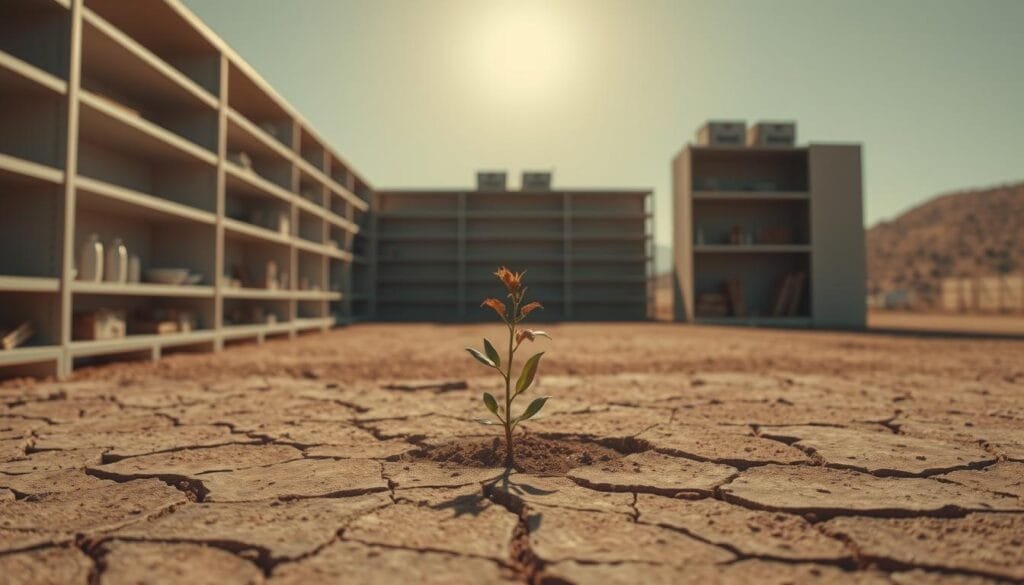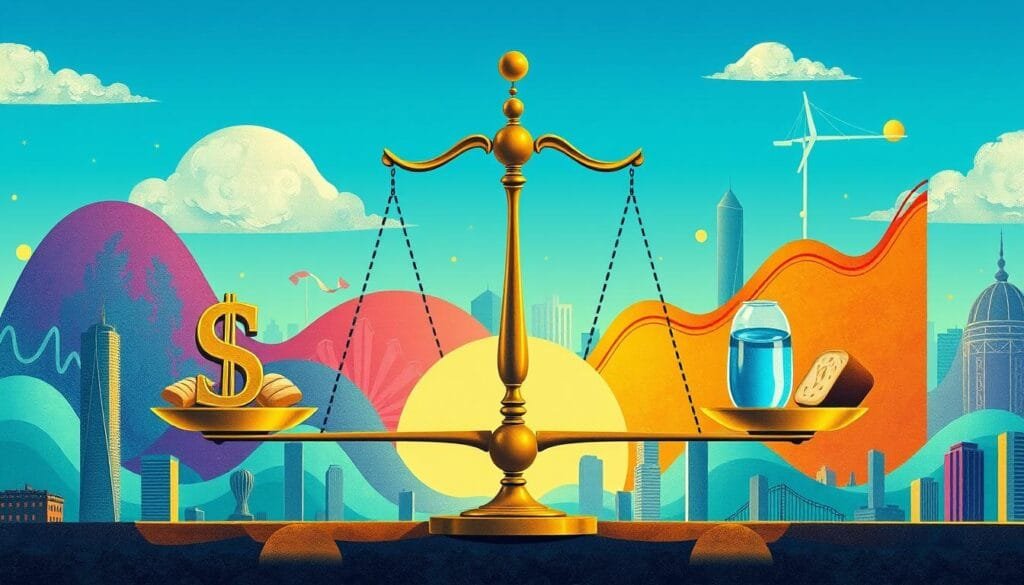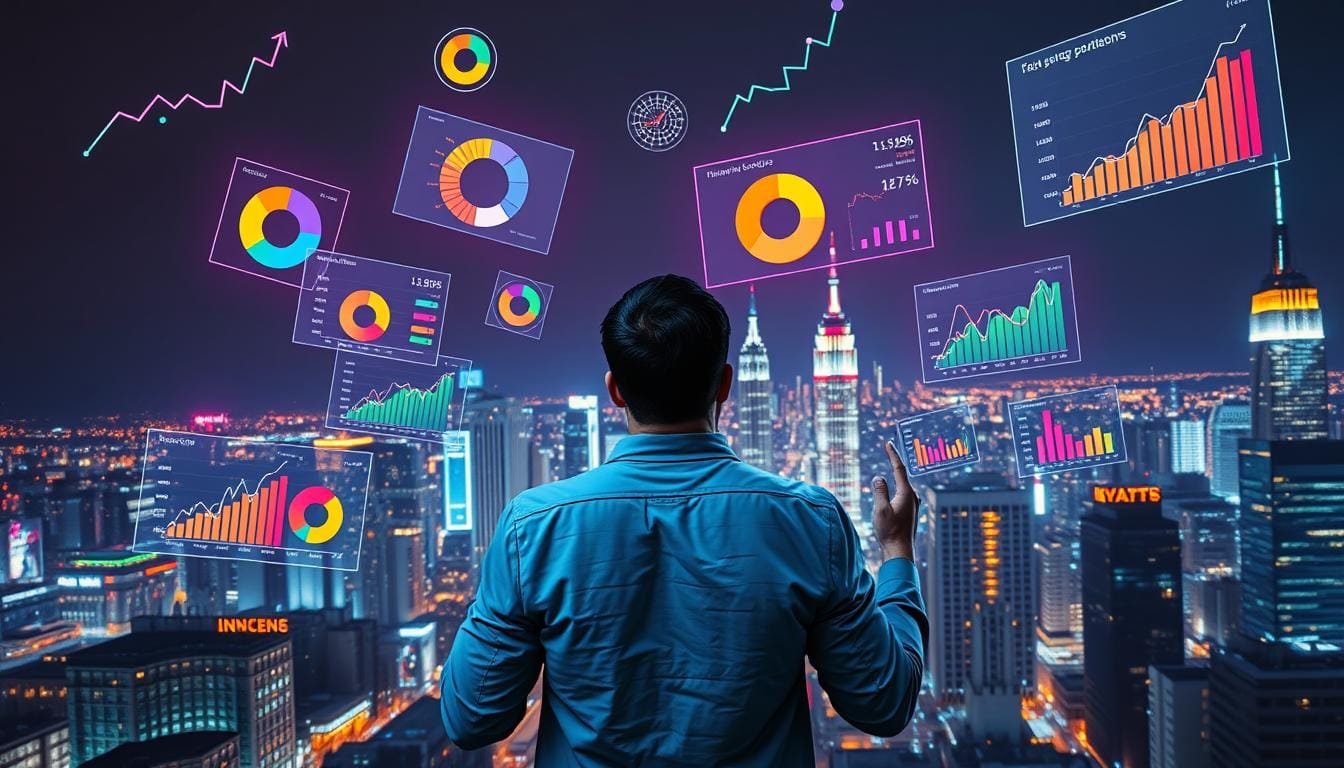Have you ever wondered how complicated economic concepts can be translated into easy-to-understand terms for everyone?
The world moves fast, making financial statements and economic data seem hard to understand. This guide will simplify the jargon for you. We aim to make sense of complex economic theories. You’ll learn how to use economics-defined statements to bring clarity. We also explain the methods to share economic terms with more people.
Key Takeaways
- Economic terminology can be simplified to enhance public understanding.
- Financial statements provide critical insights into economic health.
- Learning to interpret economic data helps in making informed decisions.
- Understanding scarcity, supply and demand, and other key concepts is essential.
- Microeconomics and macroeconomics offer different perspectives on economic issues.
Understanding Economics: A Foundation
Economics teaches us how to manage limited resources for making, sharing, and using goods and services. This introduction to economics goes beyond theory. It shows how economic principles play a part in our everyday decisions.
What Is Economics?
Economics is the study of how goods and services are made, shared, and used. It looks at choices made by people, companies, and governments about resource use. This helps us understand important market trends. The Bureau of Labor Statistics (BLS) states that 38% of U.S. economists work for government agencies. This highlights the value of economics in shaping public policy.
Some schools, like the Daniels School of Business at Purdue University, have special programs focused on economics. They cover different economic theories and data analysis. Graduates often work as financial or policy analysts and economic consultants. They find many job chances and earn good starting pay. More information on these programs is available here.
Key Takeaways of Economics
An introduction to economics must discuss key points like scarcity. Scarcity affects our choices by reminding us that resources are limited. Learning about supply and demand shows how prices and consumer behavior are connected.
Economic theories also look at cost-benefit analysis. This helps consumers choose things that give them the most value. Studies in behavioral economics tell us that 70% of buying decisions are based more on feelings than logic. This highlights the role of psychology in economics.
Incentives are crucial in economics. They can drive a company to produce more to meet rising demand. The right incentives can boost productivity greatly. There are real success stories where incentives have increased output significantly.
Understanding these fundamental economic ideas helps us see clearer how our economy works. For more details on applying these concepts in higher education, check out the economics programs at Purdue University’s Daniels School of Business.
Mandatory Concepts of Economics
Economics dives into key ideas like scarcity, market forces, economic incentives, and analyzing costs versus benefits. These concepts help make wise economic choices. They guide people and groups in the market.
Scarcity
The idea of economic scarcity is crucial in economics. Lionel Robbins in 1932 described economics as managing scarce resources for many needs. This challenge makes us choose how to best use our limited resources.
Supply and Demand
Market dynamics revolve around supply and demand. This balance affects how resources are used, impacting prices and the availability of goods. Adam Smith showed how specializing in tasks, like pin making, boosts efficiency and output.

Costs and Benefits
Cost-benefit analysis helps assess the impact of economic choices. Alfred Marshall related economics to balancing wealth and business activities. Weighing costs against benefits helps maximize economic well-being. For instance, producing more cars can lower the average cost per car.
Incentives
Economic incentives influence decisions and behaviors. They encourage excellence and efficiency. For example, rewarding specialized workers boosts productivity. Robbins’ view turns economics into a science of choices based on incentives.
Understanding these foundational concepts is key in economics. Knowing about scarcity, market forces, and incentives helps in making informed decisions. These elements illustrate the importance of balance in economic decision-making.
Branches of Economics: Microeconomics vs. Macroeconomics
The realm of economics splits into two main branches: microeconomics and macroeconomics. These branches look at different parts of economic behavior and choices.
Microeconomics
Microeconomics focuses on how people and companies make decisions. It looks at how they act in markets when dealing with limited resources. Important concepts in microeconomic theory include supply and demand and production theory. It also covers labor economics, looking at wages and job patterns. These ideas help us understand prices and resource distribution.

Supply and demand create a balance in the economy. This balance affects stock prices as buyers and sellers interact. Investors like Warren Buffett say microeconomics is key in investment decisions, even more than big economic predictions.
Macroeconomics
Macroeconomics looks at the economy on a large scale. It examines national productivity, income, prices, and jobs. Macroeconomic policy makers study things like GDP and inflation. They use this to make policies to stabilize and grow the economy. For example, during the 2008-09 Great Recession, these policies helped deal with the crisis.
Macroeconomic policies also deal with international trade and fiscal decisions. During the 2020 pandemic crash, these policies helped stock markets recover. Governments used spending and taxes to manage the economy.
Macroeconomics also looks at how changes in exports affect the whole economy. This helps in making policies for future stability and growth.
| Aspect | Microeconomics | Macroeconomics |
|---|---|---|
| Focus | Individual/business decision-making | National and government decision-making |
| Key Objectives | Supply and demand dynamics, price determination | GDP, national income, unemployment rates, inflation |
| Principles | Supply & demand, production theory, labor economics | Fiscal policy, monetary policy, trade policies |
| Impact | Stock prices, resource allocation | Economic cycles, market stability |
Both micro and macroeconomics are crucial for understanding the economy. They help predict economic trends and guide policy decisions. This leads to a strong and stable economy.
what statement uses economics to define
Economics helps explain complex scenarios in business, policy, and personal finance. It uses positive economics and normative economics to do this. Positive economics looks at hard facts. Normative economics deals with what people think should happen. Together, they make economic concepts clearer. This understanding is vital when looking at economic definitions.

Normative economics is about opinions on what should be. It focuses on values in analyzing economies. For instance, saying “everyone deserves basic healthcare” reflects personal values. This contrasts with positive economics, which uses data to find facts. Milton Friedman pushed for an unbiased look at economics based on data. A fact-based statement might be, “Free healthcare raises government costs,” which can be proved.
Debates on public policy are common because of normative economics’ subjective nature. Yet, making policies usually mixes both positive and normative views. This mix is seen in discussions on trade and welfare. An example is the debate on increasing the minimum wage to help workers. It blends values with economic facts.
In policy-making, balancing facts with goals is essential. Positive economics helps us understand and explain facts. Normative economics focuses on what our goals should be. Combining these helps policymakers create well-rounded policies. They can consider the facts and what people value. This leads to better economic decisions and policies.
The Role of an Economist
In the dynamic field of economics, economists play key roles. They shape strategic planning and decision-making in many areas. They analyze economic relationships and predict market trends. They also create policies that affect the economy of businesses and governments.
Economic consultancy is a major part of economics. Consultants offer insights to navigate complex economic situations. Financial economists look at monetary systems and interest rate effects. Meanwhile, public finance economists study government roles and assess tax cuts and budget impacts.
The economics profession has a wide range. Microeconomists focus on supply and demand at the firm and consumer levels. They aim to maximize profit and forecast consumer demand. Macroeconomists track and forecast trends like unemployment and inflation. They provide a wider economic view.
Many economists work in government, corporations, and academic areas. About 36% work for federal or state agencies, contributing to public policy. The need for economic insight in strategic decisions is growing. It is expected employment in this field will increase by 5% in the next ten years.
The median salary for an economist in 2023 is $115,730 yearly, or $55.64 hourly. This shows the profession’s lucrative nature. Top economists can become financial managers, earning about $134,180 a year.
Starting a career in economics usually needs a master’s degree. However, some government jobs may only need a bachelor’s degree. Economists in investment banks and consultancies show the demand for this expertise in various industries.
Moving up in this field often means specializing. For example, industrial economists study market structures. Labor economists look at labor supply and demand. Econometricians work on economic modeling. These specializations broaden an economist’s abilities and offer more focused job opportunities.
Key Economic Indicators
Economic indicators help analysts judge economic performance and predict financial trends. Gross Domestic Product (GDP), Consumer Price Index (CPI), and Employment Data are key. They highlight significant market indicators.
Gross Domestic Product (GDP)
GDP measures the value of goods and services a country produces in a period. It shows a nation’s economic health and offers insights into its economy. For example, in Q2 2024, consumer spending was almost 68% of the U.S. GDP. This highlights how consumer behavior shifts can indicate economic changes.
GDP growth and corporate profit growth have a strong link. This makes GDP a vital tool for policymakers and investors alike.
Consumer Price Index (CPI)
The CPI tracks the price change for consumer goods and services over time. It’s key for measuring inflation, crucial for financial predictions. As of September 2024, the U.S. inflation rate was 2.4%. This is slightly above the Federal Reserve’s 2% target.
This information helps investors understand purchasing power and living cost changes. It is essential for economic policy.
Employment Data
Employment data provide insights into the labor market’s condition. They influence economic policies and markets. As of September 2024, the U.S. unemployment rate stood at 4.1%.
This figure comes from the Department of Labor’s monthly report. It includes job numbers from both private and public sectors. Employment data, with other statistics like industrial production and home sales, highlight economic health. They are crucial for accurate financial forecasting.
Understanding Economic Systems
Studying different economic systems is key to learning how resources and society structure work. We’ll look at capitalism, socialism, and communism closely.
Capitalism
Capitalism values private ownership and the power of free markets. People and companies decide how to produce, invest, and share goods in a competitive environment. Supporters believe capitalism leads to better efficiency, more innovation, and growth. But, it might also cause unequal income and social levels.
Socialism
Socialism focuses on everyone sharing or the government controlling resources. It aims for equality and welfare, trying to reduce social gaps. Socialism can cut down poverty and support public services. However, it might face issues like inefficiency and less innovation due to fewer market competitions. The government often plays a big role in important areas, affecting the economy.
Communism
Communism is very different from capitalism and socialism because it gets rid of private ownership. Instead, everything belongs to the community. This should stop classes from forming. Yet, looking back at communism analysis, we see big problems like economic troubles, no motivation, and strict government control.
| Features | Capitalism | Socialism | Communism |
|---|---|---|---|
| Ownership | Private | Government/Shared | Community |
| Resource Allocation | Market-Driven | Regulated | Collective Planning |
| Pros | Innovation, Efficiency | Equality, Welfare | Classless Society |
| Cons | Income Inequality | Red Tape, Inefficiency | Economic Stagnation |
Learning about these economic systems shows us how complex it is to make policies. These policies must find a balance between efficiency, fairness, and new ideas in our communities.
Conclusion
We’ve come to the end of our journey through economic principles. Through this guide, we explored the basics of economics. Topics ranged from simple economic concepts to the differences between micro and macroeconomics. This summary is a great starting point for anyone interested in economics.
We’ve looked into important economic indicators like GDP, CPI, and job data. Our talk about various economic systems, such as capitalism and socialism, helped show their effects on society. Understanding these economic ideas is vital for making good choices in life and at work.
The work economists do is very important in dealing with economic issues. By using what we know about economics, people can make smarter choices about money. This article pushes for ongoing learning about economic theories. Knowing more can help you make better personal and policy decisions. Let’s use what we’ve learned to make smarter choices every day.
FAQ
What is Economics?
Economics is a study of how goods and services are produced, shared, and used. It looks at how people, businesses, and governments decide to use resources.
What are the key takeaways of Economics?
Economics teaches us about scarcity, supply and demand, and weighing costs against benefits. It helps us understand the choices we make with limited resources.
What is Scarcity?
Scarcity means our resources are limited but we want endless things. This makes us decide how to best use what we have.
How do Supply and Demand affect economics?
Supply and demand balance how resources are shared. Prices rise when demand is high but supply is low. They fall when there’s too much available. This helps everyone make economic choices.
What is a Cost-Benefit Analysis?
A cost-benefit analysis compares what you’ll spend and gain from any decision. It helps figure out if the gains are worth the costs.
What role do incentives play in economics?
Incentives motivate us to act in certain ways by offering rewards or penalties. They help us use scarce resources efficiently.
What is the difference between Microeconomics and Macroeconomics?
Microeconomics looks at decisions made by individuals or businesses. Macroeconomics looks at the whole economy, like a country’s income and job levels.
How do economic statements define complex scenarios?
Economic statements simplify complicated situations. They turn data and theories into everyday terms, giving us clear actions to take.
What roles do Economists play?
Economists study economic relations, predict market trends, and suggest policies. They help plan strategies in government, businesses, and schools.
What is Gross Domestic Product (GDP)?
GDP measures the total value of all goods and services a country makes in a certain time. It shows how well the economy is doing.
What is the Consumer Price Index (CPI)?
The CPI tracks how prices change for urban consumers buying a set of goods and services. It shows inflation levels.
How does employment data impact economics?
Employment data tells us how well the job market is doing. This info helps make economic policies and shows a country’s economic health.
What are the main economic systems?
Main economic systems are Capitalism with private ownership, Socialism with shared or government ownership, and Communism which has no private ownership at all.
